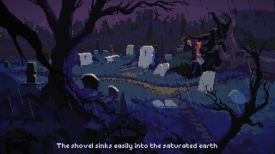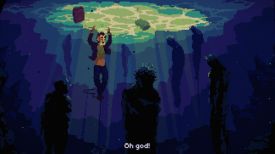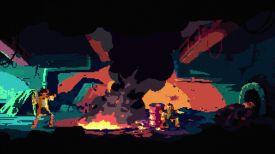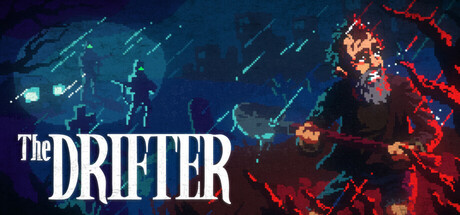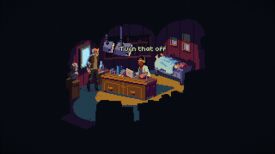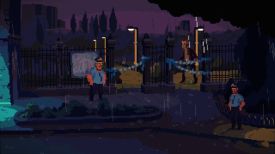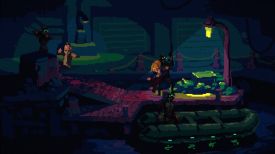|
By flotsam
The
Drifter
Powerhoof
Another piece of third person
pixel art point-and-click, The Drifter has a more retro look than some
other such games, but it doesn't detract from the goings-on. Indeed,
while generally dark and occasionally gruesome, it delivers a heap of
pulpy thrilling adventuring.
You play Mick Carter, homeless
and wandering from place to place. Having received a call from his
sister about the death of his mother, he jumps a train to make his way
back for the funeral. But a murder intervenes, one which, as the Steam
page says, sucks him "headfirst into a lunatic web of shadowy
corporations, murder, and the thousand-year obsession of a madman."
Not to mention black-ops
soldiers, something called a Mulindji, and a surprising twist or three.
And death. Mick can ‘die,’ but
will come back, and more than that he will know it has happened. Which
makes for some interesting musings, as well as the mechanics of
preventing it from happening again (and again).
It also makes for an excellent
sequence towards the end of the game where completely the opposite is
true!
If you do meet an ‘untimely’
end, you just get to try again so there is no need to have saved at a
critical point. The game autosaves, including on exit, but you can also
save at will (although not in the middle of various sequences), a
welcome part of any adventure.
It is point-and-click all the
way, the mouse doing everything. Mick won’t run but double clicking an
exit point will jump him there, and holding down the mouse will cause
Mick to follow it, including as screens slide left or right. Or just
point and click to have him move in the usual way.
The curser will reveal
information about environmental objects, as well as whether you can
interact, look or talk with whatever it is pointed at. The talk icon
when activated will pop up a row of pictograms bottom of screen
indicating topics you might ask about. Not everything will be available
for every character, and active topics will be indicated. Top of screen
is the inventory, from which you can click items and then seek to use
them in the game world or with each other. Revelations or insights are
up there as well, a flashing ‘plus’ sign indicating something has been
added.
I tended to pay attention to
those plus signs, as they could provide an indication of what to do
next. The conundrums are mainly situational – use the right item/s, have
the right conversation etc. – and whilst it isn’t a difficult game, and
patience and persistence was often rewarded, there were times when I had
little idea as to what that next thing might be. That said, in a game
with so many conundrums interwoven into an intricate narrative, I would
be surprised if I wasn’t stuck now and again.
There were also some sequences,
usually involving needing to do something (or a bunch of somethings)
before something else happened, that could become frustrating. As I like
to keep things moving along, there were times I had regard to a text
walkthrough, which provided a ‘next move’ nudge. You however may be more
pugnacious than me.
Speaking of the narrative, Mick
narrates much of what is going on, and I thought his surly laconic
undertone added to the gritty nature of things. He is at the centre of
everything, and is as complicated a character as the story he drives
forward. I liked him, pitied him even, felt for what he had gone through
and yet wouldn’t/couldn’t face. Grief, avoidance, denial; it’s a rich
tapestry.
It’s also a cracking good yarn.
Well written, it went places I wasn’t expecting, supported by a well
voiced ensemble of other characters. All of them also quintessentially
Australian, which I particularly enjoyed. Indeed, there is an
unashamedly Aussie grindhouse feel to the whole thing. An eclectic and
varied soundtrack keeps pace, underpinning the sometimes quiet,
sometimes frenetic nature of the on-screen events.
The blockier pixel art than some
other contemporary games is deceiving. The art direction, the animation,
the lighting – all are top notch and help create a vibrant and as
realistic a world as a pile of pixels can be.
I reckon at least 10 hours
awaits most players. There is some colourful language if that bothers
you.
I had a rollicking good time. A
two-person studio based in Melbourne, on the strength of The Drifter I
will be on the look out for the next Powerhoof production.
I played on:
OS:
Windows 11, 64 Bit
Processor: Intel i7-9700K 3.7GHz
RAM:
Corsair Dominator Platinum RGB DDR4 32GB
Video
card: AMD Radeon RX 580 8192MB
GameBoomers Review Guidelines
August 2025
design copyright© 2025
GameBoomers
Group
 GB
Reviews Index GB
Reviews Index |
